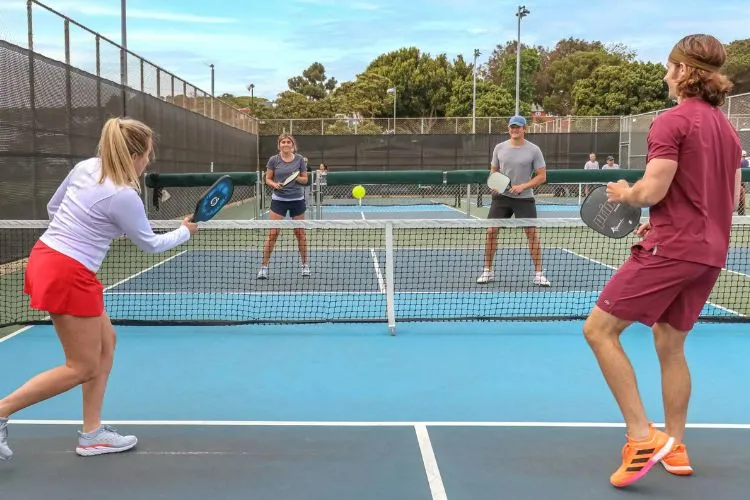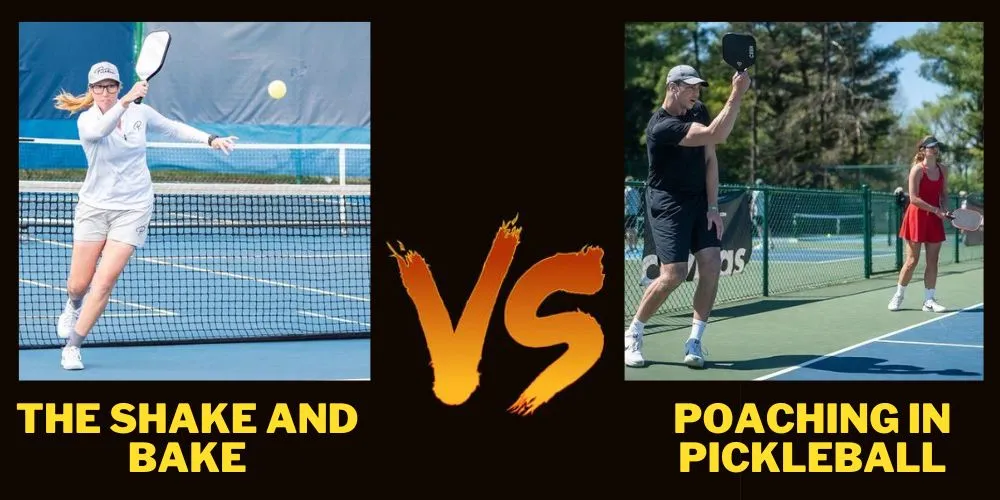Welcome to an insightful dive into one of Pickleball’s ingenious and enjoyable maneuvers, the “Shake and Bake”.
Although it may sound like a cooking method, Shake and Bake in Pickleball pertains to a tested and trusted in-game tactic. So, what is shake and bake in pickleball?

This unique strategy is rather distinctive to this spectacular sport, blending finesse and power, teamwork and coordination.
Whether you’re new to Pickleball or a seasoned player, getting a grip on the Shake and Bake could up your game immensely.
Let’s navigate this thrilling approach together. Prepare to master the art of the Shake and Bake in Pickleball!
What is shake and bake in pickleball?
The term “Shake and Bake” might remind many of us of a popular cooking method, but in the context of Pickleball, it identifies an exciting doubles strategy known for its effectiveness and thrill.
- Setting The Stage: The Shake and Bake move unfolds in a specific sequence. It starts off with one player serving to the opposing team. The served ball, as per the Pickleball rules, must bounce once before it’s returned.
- The Shake: “The Shake” is the second shot hit by the player’s teammate. This shot, ideally, is a powerful, low and fast drive aimed at the opponents. The intent behind the drive is to force the opponents to make an upward return. This is advantageous because it sets up the forthcoming shot, “The Bake”.
- The Bake: Once the “shake” is executed, the player who made the initial serve moves forward towards the net, anticipating the opponents’ upward return. When the return is made, they then executes “the Bake”. The Bake is a slam or smash, ideally a volley, aimed to end the rally by hitting an offensive shot that is difficult for the opponents to return.
The Shake and Bake strategy relies heavily on teamwork, timing, and precision. Both players must coordinate well to execute the fast-paced drive (Shake) and the decisive slam (Bake). This strategy is seen as an offensive tactic that applies pressure on the opponent right from the start of the rally.
If executed correctly, Shake and Bake is an effective and entertaining part of Pickleball that can be instrumental in keeping opponents on their toes while amplifying the energy and excitement of the game.
Understanding the Difference: Shake and Bake Vs Poaching in Pickleball
Many tactics and strategies in Pickleball blend finesse, agility and strategy, two of which are the Shake and Bake and Poaching methods. At first glance, these methods may appear similar, but there are distinctive aspects that set them apart.

The Shake and Bake
In a nutshell, the Shake and Bake in Pickleball is a power-play strategy employed in doubles play. Here’s how it goes:
- Setting Up: It starts with one player serving to the opposing team. The ball must bounce once before it’s returned.
- The Shake: The player’s teammate hits the third shot in the rally as a fast and low driving shot (the Shake), aimed at forcing the opponents to make an upward return.
- The Bake: The player who made the initial serve then moves forward towards the net, executing an offensive volley or smash against the returned shot (the Bake). This shot ends the rally with an offensive shot that is hard for the opponents to return.
Poaching in Pickleball
Poaching, on the other hand, is a strategy mainly used to intercept a ball in doubles play. Here’s how it works:
- Setting Up: One player (usually the one closer to the net) monitors the rally closely, waiting for the right moment.
- The Poach: The moment arrives when the ball is hit towards their partner. Instead of allowing the partner to hit the ball, the ‘net’ player intercepts or ‘poaches’ the ball, usually with an aggressive volley aimed at ending the rally.
The Key Differences
While both the Shake and Bake and Poaching involve strategic positioning, the key differentiation lies in the execution and intent of the two strategies:
- Team Coordination: While both methods require teamwork, the Shake and Bake requires a controlled sequence of shots between partners, whereas poaching involves a surprise interception by one partner, often unbeknownst to the other partner.
- Shot Execution: The Shake and Bake features a hard-driven shot followed by an offensive volley, while poaching mainly involves a sudden aggressive volley.
- Timing: Shake and Bake is planned at the start of the rally, while poaching usually unfolds as the rally progresses, based on the opponents’ shot.
Although they differ, both the Shake and Bake and Poaching are interesting strategies that can add different dimensions to a Pickleball game. They cater to different game scenarios and preferences of play, but adopting both could offer players a more versatile game approach.
You may also find useful: What is a Spike in Pickleball? | What Is Dupr In Pickleball?
Conclusion:
Pickleball is a sport filled with fascinating strategies and techniques, one of which is the “Shake and Bake”. A far cry from culinary nomenclature, the “Shake and Bake” tactic adds a captivating dimension to doubles Pickleball play.
The successful execution of this strategy requires impeccable teamwork, timing, and precision. The “Shake” – the low, fast drive – and the “Bake” – the smashing volley – come together to surprise the opponents and take control of the rally.
As we explore the world of Pickleball, we realize that strategic play is as important as physical prowess.
Unleashing the perfect “Shake and Bake”, or mastering the art of other techniques such as Poaching, can truly elevate your Pickleball game. Each game strategy, with its unique attributes, reflects the dynamic and exciting nature of this sport.
Like any other game tactic, developing a solid “Shake and Bake” routine requires practice. So, the next time you step onto the Pickleball court, remember to experiment with this powerful play.

Pickleball’s more than a game to me—it’s a passion. I write, sharing its highs and lows, the thrills and the lessons. Some tales might draw you to the court, while others give a hint of the game’s magic. So, curious about my journey? Ready to dive deep into the world of pickleball with me? Let’s go.
